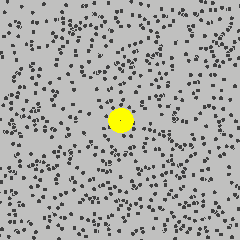Scientists prove possibility of 'impossible' dust transition in turbulent flow

Researchers from MIPT and the Weizmann Institute of Science (Israel) have predicted the possibility of negative turbophoresis, a phenomenon where impurity particles inside a turbulent flow move in an "impossible" direction. The study by Sergei Belan (a postgraduate at MIPT), Grigory Falkovich and Itzhak Fouxon was published in the journal Physical Review Letters in the Editors' Suggestions section, which features the most important and interesting studies from the editorial board's point of view.
The researchers studied the behavior of inertial particles in different environments where they were exposed to random forces. Examples of such systems include Brownian particles in a thermostat (a heated fluid, for example), dust particles and aerosols in turbulent gas flows. In the case of Brownian motion, a random force emerges due to chaotic collisions of the molecules of a thermostat.
A particle in a turbulent flow is subjected to Stokes' law of friction force, which is proportional to the difference of the velocities of the particle and fluid at the point considered. Since the velocity of turbulent gas changes chaotically, the resultant frictional force can also be considered chaotic. It has been known since Maxwell's time that the heterogeneity of thermostat temperatures (i.e. the heterogeneity of the intensity of a random force) makes particles flow in the direction of lower temperatures. This phenomenon, called thermophoresis, is very common in nature and is used in a number of devices.
A typical example is the blackening of the surface of an oil lamp: the temperature gradient "pushes" soot particles away from the flame, which makes them deposit on the glass of the lamp. The thermophoresis effect is used to manipulate nanoparticles and to clean air from submicron-size particles. In the case of inertial particles in turbulent flows, a similar effect called turbophoresis is observed. This phenomenon emerges, for example, when dust and aerosols move in the atmosphere, when reagents are stirred in chemical reactors or when impurity particles deposit on tubes.
For many years it was believed that thermophoresis / turbophoresis inevitably leads to the accumulation of particles in the field of low temperatures / low turbulence. The generally accepted view was that particles in a turbulent flow always migrate towards the walls. The new article says this was an erroneous conclusion. Having examined the behavior of particles near the minimum of turbulence, the researchers showed the possibility of negative turbophoresis for sufficiently heavy particles when the flow moves towards greater intensity. The theoretical model they presented allows for determining the critical value of the inertia, wherein the sign of the particle flow changes from positive to negative.
As the researchers explained in their paper, this is a new type of phase transition: depending on the parameter of inertia the cloud of inertial particles is either localized, concentrating near the minimum of turbulence, or delocalized, leaving the vicinity of this minimum. Now the most interesting question is how accurately the proposed theoretical model describes the behavior of particles in real turbulent flows. At the moment, the researchers are seeking confirmation of the effect they predicted.
Journal information: Physical Review Letters
Provided by Moscow Institute of Physics and Technology




















